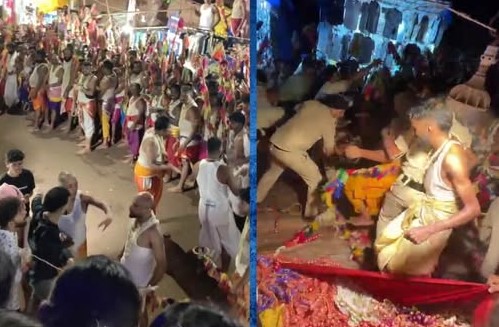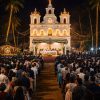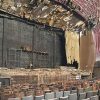Goa is abuzz with excitement as vintage bike and car owners, users, collectors and fans are decking […]

FRENZY CAUSES STAMPEDE!
In the News, May 10- May 16, 2025 May 9, 2025By Rajan Narayan
THE stampede at the Lairai temple, Shirgao in Assonora, north Goa, was a disaster waiting to happen. Shirgao is a small village with a population of just 2,000 villagers but attracts almost a lakh of pilgrims on the night of the “homkund.” This is the ritual of walking or rather running quickly over live coals which marks the ultimate act of devotion to the goddess.
The homkund is located on a narrow slope at the end of one of the two small roads in the village. The “Dhonds” — the pilgrims who take part in the homkund ritual observe a strict discipline and are in a state of deep mental devotion. All of them rush single minded towards the burning bed of coals to walk across it in quick succession. An increasing number of Dhonds observe this ritual of walking on burning coals annually.
Perhaps there was bad regulation of the fire walking this year and there were no CCTV cameras to identify who was responsible for starting the stampede. There was no protocol in place for those who participated in the rituals and those who came to witness the devotion. In any case, we doubt if the police would have dared to interfere with this age-old ritual of homkund. It was the responsibility of the temple committee and its president to ensure movement of pilgrims to the temple to pray and witness the ritual.
WOMEN VICTIMS
AS the reports go there was a woman pilgrim who stumbled and fell down. The crowd behind her continued to rush forward ignoring what had happened and in the resulting stampede six people lost their lives and 60 were injured.
There was no infrastructure in place to cope with a disaster of this kind. The police on duty were apparently unaware about the stampede till they were informed about by some pilgrims. The First Aid Centre was also ignorant about what had happened. The chairman of the temple committee, Dinanath Gaonkar, has admitted that there was no discipline among the “dhonds.” He had even requested permission from the government to close the temple for devotees on May 6, the final day of the jatra. Except for the Chowgules, who are apparently the big donors. The festival continued on Sunday, May 4 through Monday, May 5 — despite the disaster which occurred at about 3 am on the second day of the 5-day jatra.
Clearly, it was a failure on the part of the temple authority, also the district administration and the police. The disaster management officials pointed out that the standard operating procedure was not in place. Ironically, even after the disaster, the temple committee continued to welcome special guests including South Goa MP Capt Viriato Fernandas and Goa Foundation couple Claude and Norma Alvares who are regular pilgrims at the jatra. Claude Alvares posted pictures of their presence there. The Goa Foundation has fought it out in court to protect the villagers against the ravages of mine owners.
And never mind that the government with some remorse cancelled all its formal programs for three days as a sign of mourning after the Shirgao stampede tragedy occurred. This is perhaps the first time in the history of this ritual celebration that a stampede of this dimension has happened and so many lives lost in Goa.
RELIGIOUS JATRA
DESPITE the fact that many religious jatra take place in Goa and these attract large crowds, clearly this Shirgao jatra an impression has been created that there’s no crowd management at the Devi Lairai homkund area – compare this in contrast to the over 80 lakh pilgrims who visited the relics of St Francis Xavier in December 2024 and January 2025.
There are large crowds present at the feast of the Milagres church in Mapusa which was celebrated only the few days before the Shirgao jatra. The legend is that Our Lady of Milagres and the Devi Lairai of Shirgao are sisters. There are other events like the “fama”– the feast of the Infant Jesus, which attracts huge crowds in Colva. There is a “Santana” feast in Talaulim in Tiswadi taluka, where couples offer cucumbers to St Anne (mother of Mother Mary) for the gift of children. There are the jatra of Shantadurga at Fatorda, the “gulal” festival at Zambaulim, the “saptah” at Vasco da Gama port city which all attracts huge crowds. Due to strict management there have never been a disaster and a tragedy on the scale of the stampede which took place at the Shirgao jatra last week.
Stampedes seem to occur when the focus of worship is a single point at a pilgrimage destination. Stampedes have occurred twice during the Khumb mela held early at Prayagraj, once at the Kumbh mela itself and another at the New Delhi station when pilgrims rushed to catch the train to Prayagraj. The Kumbh mela stampede tragedy happened when the pilgrims here were rushing to a particular spot where the Ganga river met the Jamuna and legendary Saraswati – the sangam spot of three sacred rivers of Hindu religious legends. This is considered the holies of holy spots for a ritual bath by pilgrims.
There were no separate entry and exit points and the most holy time for the dip in the cold waters of the rivers was at 4am in the morning. The huge rush of pilgrims could not controlled by police or the large number of volunteers at Prayagraj. In the other incident of a stampede, over 5,000 passengers were sold tickets for a train which could accommodate a 1,000 pilgrim going to Prayagraj for the Kumbh mela.
FAMOUS STAMPEDES
STAMPEDES are not limited only to Hindu pilgrimages. On several occasions stampedes have claimed lives during the Haj pilgrimage in Saudi Arabia. All these stampedes occurred not at Mecca, but Madina. They occurred at a site where pilgrims stone the devil or “shaitan.” As in the case of Kumbh or the Larai jatra there area crowd of pilgrims rushing towards the stone pillars of “shaitan” — or the carpet of live coals at Shirdao. In the mass frenzy of people some lose their life in stressful tragedies. Mind you this happens in Saudi Arabia which has very strict laws and a very good security system. Perhaps nobody can control a mob in a frenzy of devotional passion.
Interestingly, there have been no incidents of frenzy at Catholic events or places of worship. There are huge crowds at various of Catholic Pilgrim places like the shrine of Lourdes in Portugal, or the shrine of Our Lady of Fatima in Spain. The visit of the Pope to various countries attracts masses of people.
Over two lakh people attended the mass of Pope John Paul II at the Campal grounds in February 1986. There was excellent crowd control management. There were barricades to ensure crowds came to the venue and disbursed in an orderly manner. Interestingly, the then collector was Shakti Sinha, an IAS officer who subsequently became private secretary to Prime Minister Atal Bihari Vajpayee.
I was present in the first row during the high mass conducted by Pope John Paul II. The crowd of over two lakh dispersed peacefully after the mass within a half hour.
Over 2.5 lakh pilgrim attended the funeral mass of Pope Francis at the St Peter’s Square of Vatican City. The mass proceeded peacefully despite the presence of world leaders including USA’s Donald Trump and India’s President Draupadi Murmu attending the funeral mass.
CRICKET FRENZY
THERE have been any number of reports of horrible stampedes and crushes at sports events in Goa. It may be recalled that there was a major stampede and violence during the 1-day cricket match between India and England held at the Fatorda stadium. The Goa Cricket Association headed by Dayanand Narvekar sold double the quantity of tickets beyond the capacity of the stadium.
There were huge clashes between the two groups of asli and nakli ticket holders. There were forged VVIP passes and there were fights in the VVIP area which I witnessed because I was present at the event. The then Chief Minister Manohar Parrikar ordered a lathi charge against the crowds with tickets wanting to enter the stadium. Several people were injured in the lathi charge.
The state government is reluctant to interfere with Hindu festivals. Both the Centre and the State government do not want a Hindutva state to encroach on the autonomy of a religious organization. The truth is that temple and jatra organisers, including Uttar Pradesh Chief Minister Yogi Adityanath, are not experts in crowd control.
Dealing with large crowds requires organizational experience and diplomacy skills. People gathering at a mass event of a religious nature especially are in a state of high excitement. Fool proof arrangements must be made to ensure order and discipline. It is the primary responsibility of the temple, church or mosque committee to ensure disciple amongst devotees.
The Dhonds are a very powerful community in Goa and are very close to the ruling BJP. This might explain the reluctance to regulate the number of Dhonds wanting to participate in the jatra’s homkund rituals. Ironically, there were an estimated 1,000 police personnel deployed at the right place and right time. It is their failure to manage the event that resulted in the fatal stampede.















